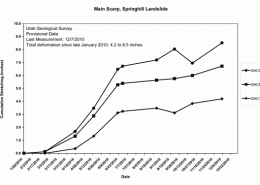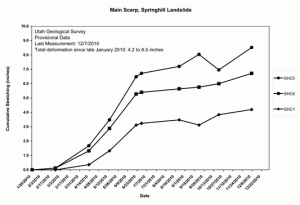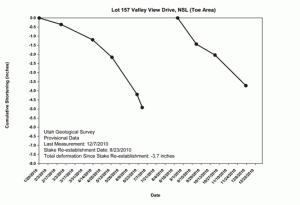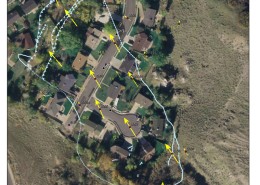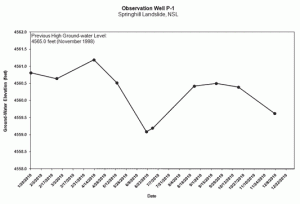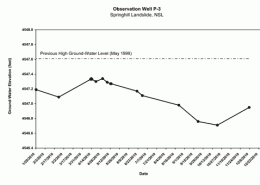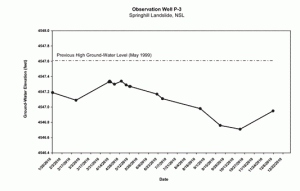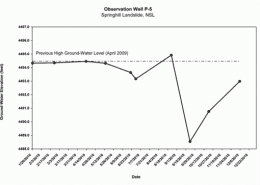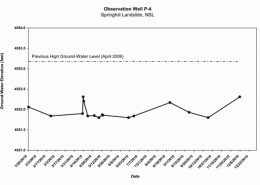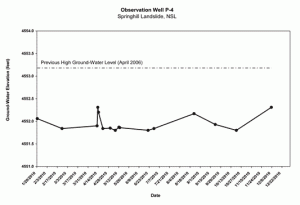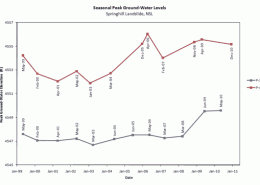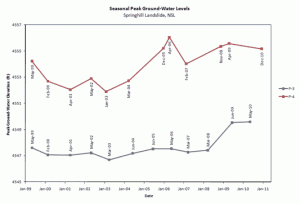Summary of Springhill Landslide Movement and Conditions in 2010
This section summarizes landslide conditions from January 20 through December 7, 2010. Precipitation for the water year is also discussed.
Landslide Movement
The landslide was active in 2010 and had been continuously moving at a very slow rate since at least January 2008. Measurements indicate that different parts of the landslide were moving at slightly different rates. In general, the landslide moved to the northwest, toward Valley View Drive. Ground deformation measurements were collected from survey markers using a steel measuring tape and a survey-grade GPS instrument, depending on location.
The UGS monitored ground deformation at several locations on the landslide with wooden stakes to estimate approximate movement. At the head or main scarp of the landslide (uppermost part), stretching (points on the ground get farther apart) occurred due to landslide movement. At the toe of the landslide (lowermost part), shortening (points on the ground get closer together) occurred.
The two plots below show the cumulative stretching and shortening (the amount that occurs over a period of time from an initial measurement date) at the main scarp and near the toe of the landslide in 2010. The main scarp experienced about 4.2 inches (at station SHC1) and 8.5 inches (at station SHC5) of cumulative stretching across the main scarp zone.
Measurement of the cumulative shorting of the landslide at the toe has been complicated because of the destruction and re-establishment of several survey stakes as the result of tree removal at the site. Cumulative shortening across the toe of the landslide (located in Lot 157 Valley View Drive) between late January and June 29 was about 4.9 inches. Destruction of our survey stakes resulted in a gap in our data from June 29 until August 23 when the stakes were re-established. From August 23 until December 7, movement at the toe was about 3.7 inches. Therefore, the total landslide movement at the toe since late January is not precisely known, but is estimated to be greater than 8.6 inches.
The table and index map below summarizes total measured ground deformation in 2010.
Summary of recent landslide ground deformation measurements
| Description | Location | Measurement Method |
Measurement Period |
Total Movement |
Estimated Error |
|---|---|---|---|---|---|
| Ground deformation across main scarp zone | Upslope of Springhill Circle | Steel tape and survey stakes | January 20 – December 7 |
4.2 to 8.5 |
±0.1 |
| Ground deformation across toe | Lot 157 Valley View Drive |
Steel tape and survey stakes | January 20 – June 29
June 29 – August 23 August 23 –December 7 |
4.9 No Data Available 3.7 |
±0.4 |
| Movement monitoring | Entire landslide and surrounding area | Survey-grade GPS instrument | June 29, 2010 – October 20, 2010 |
0.4 to 10.2 |
±0.75 |
Change in the Rate of Movement
Monitoring showed consistently slow movement of the landslide since at least 2008. Repeated monitoring of the rate of movement (the rate of change observed between measurement intervals) allows us to assess changes in these movement rates.
At the head of the landslide, significant changes in the rate of landslide movement was observed three times during 2010, increasing during the transition from winter to early summer, slowing through late summer, and slightly increasing in fall. This pattern of 2010 landslide movement rates is consistent with other Wasatch Front landslides. Generally, landslides along the Wasatch Front experience most of their damaging landslide movement in the spring and early summer months when precipitation and/or snow melt is generally the greatest.
At the toe of the landslide, the rate of landslide movement was complicated because of the destruction of several survey stakes as the result of tree removal at the site, and the need for re-establishment of these points. The rate of change increased across the toe of the landslide between late January and June 29. Destruction of our survey stakes resulted in a gap in our data from June 29 until August 23 when the stakes were re-established. From August 23 through December 7, the rate of the change at the toe of the landslide decreased.
Ground-Water Levels
UGS geologists last measured ground-water levels at the landslide in December 2010. In three of the four observation wells (P-1, P-3, and P-5) ground-water levels fell slightly in 2010. Of the three wells, P-5 experienced the most variability; water levels exceeded the highest level recorded (from 2009) in August, but then fell 6.38 feet the next month, only to rise to again by the end of the year. Although such a rapid change is rare in this monitoring well, it is not without precedent. Similar fluctuations were observed in the latter half of 2006. The cause of this large variability of ground water levels in well P-5 is unknown. Ground-water levels in well P-4 climbed slightly during the year. Throughout the year, ground-water levels in three of the wells (P-1, P-3, and P-4) only varied from the January 20 water level by 2.5 feet and all ended the year within 1.5 feet of the initial water level.
Seasonal Peak Ground-Water Levels
Fluctuations in the seasonal peak ground-water level (SPGWL) provide a relative measure of the landslide’s stability. Between 1999 and 2010, the SPGWLs in the four wells in Springhill Drive typically occurred in the first six months of the year, suggesting ground-water levels rise in response to snowmelt and spring precipitation (generally the wettest months of the year are March through May). A comparison of groundwater levels and precipitation patterns in 2010 show this same relationship.
The plot below shows the fluctuations in the SPGWL in observation wells P-3 and P-4 (both in Springhill Drive) since 1999. The high SPGWLs since 2005 coincide with an increase in annual movement, which ranges from about 4.0 (in 2005) to 10.2 inches (in 2010).
Precipitation in 2010 and the 2009-2010 Water Year
Precipitation at the landslide is estimated using data from the nearby Bountiful Val Verda National Weather Service station, approximately 1.5 miles northeast of the landslide. Precipitation for the 2009-2010 water year (October 2009-September 2010) was 99 percent of normal. For the first three months of the current water year (October 2010-December 2010), precipitation was 195 percent of normal. For the 2010 calendar year, precipitation was 125 percent of normal with peak precipitation occurring in April and May.


